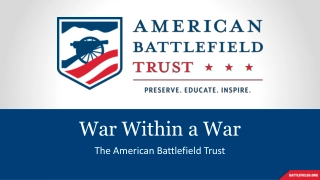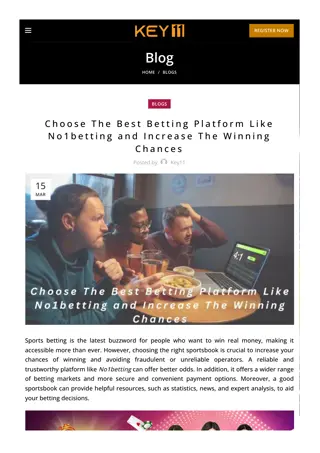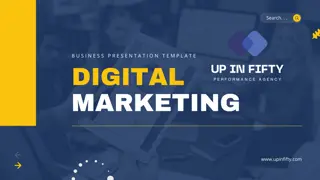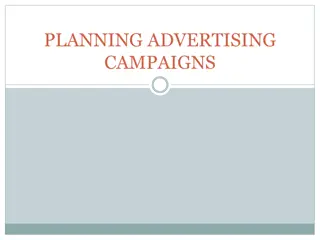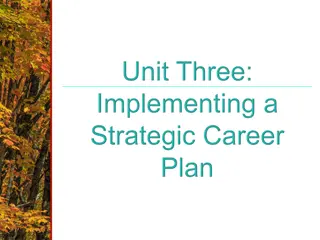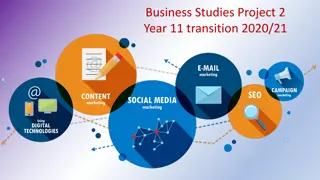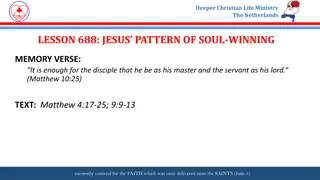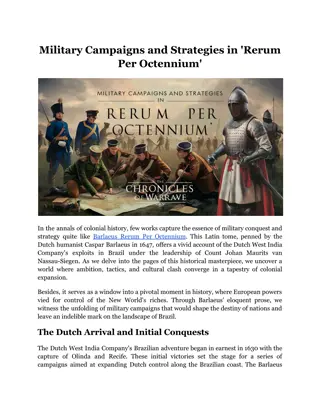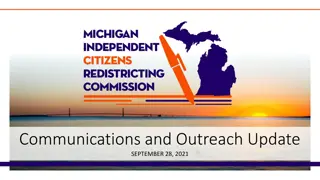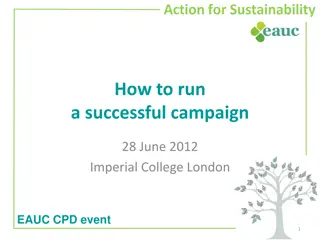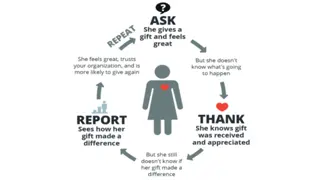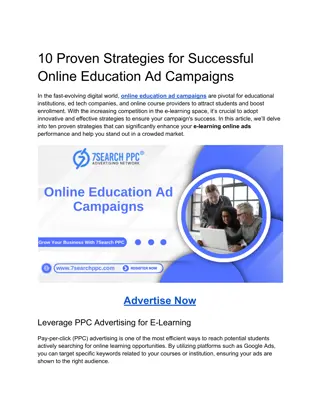Strategies for Winning with Comprehensive Campaigns
Comprehensive campaigns in labor organizing require a strategic approach involving research, coalition-building, and various pressures to influence decision-makers. Key concepts include leveraging relationships, escalation, compression, following the money, and more, with the ultimate goal of gaining power through worker mobilization and advocacy for better workplace conditions. Employers, as complex organizations, necessitate targeted tactics for effective campaigning both within and outside the workplace to achieve success.
Download Presentation

Please find below an Image/Link to download the presentation.
The content on the website is provided AS IS for your information and personal use only. It may not be sold, licensed, or shared on other websites without obtaining consent from the author. Download presentation by click this link. If you encounter any issues during the download, it is possible that the publisher has removed the file from their server.
E N D
Presentation Transcript
Strategic campaigning What does it take to win?
Comprehensive campaigns Union organising or a collective bargaining campaign Heavy focus on research The use of community coalition-building Publicity and public pressure Political and regulatory pressure Economic and legal pressure Traditional organising tactics. Comprehensive campaigns can be costly and require organisational expertise. However, increasing numbers of unions are building comprehensive campaign capabilities.
Campaign elements Mapping Research Activist & worker organising Member actions, mobilising Solidarity and support Clients, suppliers Legal Media Government & political NGOs, community Investors, shareholders
Comprehensive campaigns 10 key concepts 1. Leverage syllogism Who is decision-maker who can grant what we want? What is important to that decision-maker? How do we gain influence over what s important for that decision-maker? Escalation Compression Follow the money Target a niche 6. High ground & backlash 7. Militant minority and majority 8. Worker issues, collateral issues 9. Visibility, economic impact 10. Carrots & sticks 2. 3. 4. 5.
Employers can be vast and complex organisations and an inter-connecting web of relationships
We use comprehensive campaigns because we need more than workplace organising to win GROUND Workplace organising Non-union workers Members INTERNAL Within the union Integrate bargaining Use employer relations Other union assets Focus and resources AIR Outside the workplace Message: worker justice Message: bad corporate citizen Company image (clients & customers) Economic pressure (when needed) Community, political & other allies
Our goal is power Exercise power in the workplace, and outside Organise & mobilise workers via issues Raise standards, build sustainable structures Gain power through winning
Analyse the business and the market How is the market segmented? Who are key customers & clients? What are the most profitable sales? Where is the important growth? How do sales contracts work?
Analyse the chain of production Where is profit made? Who controls key stages? What are chokepoints? Retail chains (leverage) Wholesalers Plant nurseries Growers (300) Coolers (7) Processors (target) (employers) Strawberry Campaign
Map the employers & worksites and the union Key owner A Key Owner B Key owner C Key owner D Contractor X Contractor Y Contractor Z # of workers, # of members at each site
The best chunk (of an industry, of a company, etc.) Sexy (excites the union) Resonant (victory impresses other employers, workers) Winnable (especially first efforts soft, leverage-able) Manageable in scale (within our capacity & resources) Meaningful (measurable membership gain or CLA impact)
Formulate an initial strategy What is the organising approach? What are the potential targets? Is there leverage? What scale of resources? What time frame?
Financiers / investors Owners Community Suppliers Government Company Media regulatory Customers / Other business interests clients Workers
Approval for campaign Engage key leaders democratic mandate Calculate needed resources Ground Leverage needs Other air (communications, etc.) Does it fit within overall industry & union growth strategy?
Develop ground, air & internal elements Strategy includes campaign activities Ground Vibrant non-union worker activity Member mobilisation Internal Integrate bargaining (peak) Organisational focus Air Message: worker justice and bad corporate citizen (high moral ground) Company image (clients & customers) Economic pressure Community, political & other allies Organising Bargaining strategy Union employer relations Media & communications Community & issue allies Political allies & elected support Strategic research Capital strategies Offensive legal
Campaign Goals Campaign Element Goals Activities Research Profile of company and Identify investors Search internet for answers to company profile questions Field: Activists & Worker Organising Increase density to 60% Train 50 activists Build 5 Area Committees Map company geographically in city Conduct systematic 1:1 contact of workers in key areas Identify 1 activist for every 10 workers Field: Member actions Gather 1000 signatures for petition on a winnable issue Ask 20 key activists to gather 50 signatures each Legal Media Governmen t & Political NGOs, Community Identify 3 NGO groups that will sign in support Identify NGOs that campaign on poverty/relevant issues. Conduct individual meetings with NGO leaders Client
Campaign Planning Campaign Element Activity Month 1 Activity Month 2 Activity Month 3 Activity Month 4 Activity Month 5 Activity Month 6 Research Field: Activists worker Organising & actions Legal Media Government & Political NGOs, Community Investors Client
Ground war: activating workers around issues Select a workplace issue important to workers Assess support focus on 2 & 3 Identify potential issues Identify the decision-maker and the solution Map worksite shifts & departments Educate & inoculate supporters Target a worksite Initial worker outreach Identify activists Acquire lists of workers Mobilise support confront the boss Increase visibility Extend & deepen reach Identify & test leaders Publicise victory!
Air war: Issue campaigning outside the workplace Obtain government records Inspection records Consumer complaints Financial records Court records Prepare critiques in other states State legislative testimony Federal regulations process & legislation Regulatory interventions Company expansion Company loans & subsidies Interview advocates & activists Outreach to investors & financiers about increased scrutiny Coalition building Nursing home advocates Patient families Prepare critique Deficiency patterns Complaint findings Penalties & enforcement Spending patterns Public policy implications Outreach to negligence lawyers Annual state budget process National media outlets State regulatory reform Press conference & media outreach Outreach to other countries State investigations
Internal campaign Manifestations? Identify & train activists, expand workplace structures Announce demands workplace communication external communication Industrial action? Survey key worker issues economic non-economic Generate worksite activity Generate external support activity Organise ( let s be strong and win ) Table
Global elements Network activation, membership mobilisation and solidarity activity Coordinated employer relations activity Financial & staff support Worker-worker and leader Tours (inbound, outbound) Leverage & visibility activities Industrial action
Results Public sees White paper Brochures & leaflets Issue expos s Rallies & demo s Allies & supporters Worker Justice Bad corporate citizen Press coverage Paid media Global activity Leverage activity Employer sees Activated employees, workplace leaders. Tension in relationship Union marshalling its assets & focusing its resources Activated network other workplaces joining the fight Interventions in non- worksite company activities, key stakeholders being affected Economic damage? Brand damage? Workers see United co-workers, active leaders, workplace wins More power bargaining Union is mobilising, galvanising Broad support in community, workplace, global Media our fight is important We have power to fight the boss
Key campaign staff roles Leader Campaign director (driver) Strategy Overall plan 24/7 whip Create & maintain space Keep leader engaged & briefed Organiser Members & non-members Workplace fights & victories Backlash Troops for activity Researcher Strategy Boss s view Business plan Impact on profit Visibility activity Leverage activity Communicator External paid & earned media Industry broadcast Worker message, workplace communication Website Visibility & leverage activity Worker Justice & Bad corporate citizen Union reps & officials Employer relations at target, competitors Negotiations Other worksites Resources Strategy Key decisions Settlement
Key worker campaign roles Works council delegates Business plan & information Coordinated activity Worksite leaders Campaign spokesperson Lead workplace fights Expand & strengthen union Approve settlement Others?
Comprehensive campaign escalates compresses creates a crisis Settlement organising rights improved agreement union victory
Assess and review Celebrate success Analyse success Review tactics and strategy Lessons learned Make a new campaign


